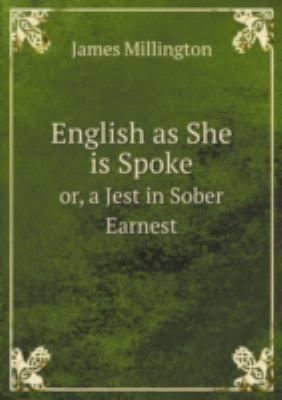7.8 /10 1 Votes
Publication date 1883 Pages 60 Genre Phrase book Country Portuguese Language | 3.9/5 Goodreads Media type print Originally published 1883 Page count 60 Publisher D. Appleton & Company | |||||||||||||||||||||||||||||||||
 | ||||||||||||||||||||||||||||||||||
Original title O novo guia da conversação em portuguez e inglez Text English As She Is Spoke at Wikisource Similar English as she is taught, Dangerous Frames: How Idea, The Chess Machine, The Secret Life of Emily Dic, Americans in Paris | ||||||||||||||||||||||||||||||||||
English As She Is Spoke is the common name of a 19th-century book written by Pedro Carolino, and falsely additionally credited to José da Fonseca, which was intended as a Portuguese–English conversational guide or phrase book, but is regarded as a classic source of unintentional humour, as the given English translations are generally completely incoherent.
Contents
The humour appears to be a result of dictionary-aided literal translation, which causes many idiomatic expressions to be translated wildly inappropriately. For example, the Portuguese phrase chover a cântaros is translated as raining in jars, whereas an idiomatic English translation would be raining buckets.
It is widely believed that Carolino could not speak English, and that a French–English dictionary was used to translate an earlier Portuguese–French phrase book, O novo guia da conversação em francês e português, written by José da Fonseca. Carolino likely added Fonseca's name to the book without his permission in an attempt to give it some credibility. The Portuguese–French phrase book is apparently a competent work, without the defects that characterize English As She Is Spoke.
Cultural appraisals and influence
Mark Twain said of English As She Is Spoke that "Nobody can add to the absurdity of this book, nobody can imitate it successfully, nobody can hope to produce its fellow; it is perfect."
Stephen Pile mentions this work in The Book of Heroic Failures, and comments: "Is there anything in conventional English which could equal the vividness of 'to craunch a marmoset'?" The original has "to craunch the marmoset", an entry under the book's "Idiotisms and Proverbs." This is the author's attempt to translate the French slang idiomatic expression croquer le marmot, used to indicate "waiting patiently for someone to open a door", with croquer referring to the "knocking" or "rapping" sound and marmot, a term for the grotesque door knockers in vogue at the time. The term is presumably inspired by the marmot's large teeth, as many of the grotesque door knockers were figures holding the knocker clasped in their teeth.
Tristan Bernard wrote a very short comedy with a similar name, L'Anglais tel qu'on le parle. Ionesco's La Cantatrice Chauve is mostly made of language conversation book lines used out of context.
Publication history
Related titles
The phrase inspired some other publications, notably:
Contemporary allusions
The phrase English as she is spoke is nowadays used allusively, in a form of linguistic play, as a stereotypical example of bad English grammar.
The book is given as one example of many diversions that President Abraham Lincoln used to lighten his heart and mind from the weight of the Civil War and his cabinet's political infighting.
